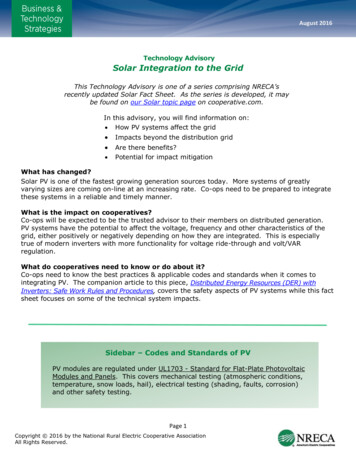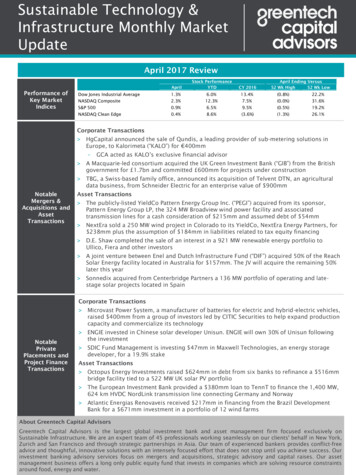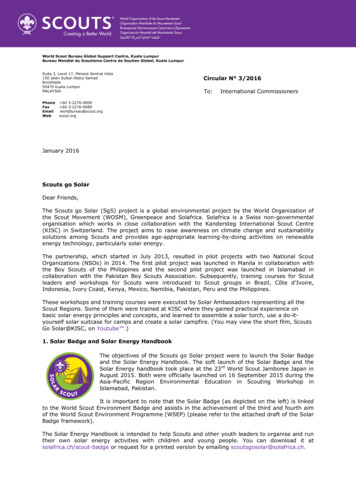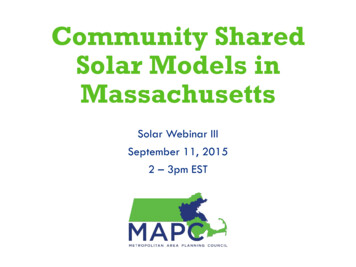
Transcription
August 2016Technology AdvisorySolar Integration to the GridThis Technology Advisory is one of a series comprising NRECA’srecently updated Solar Fact Sheet. As the series is developed, it maybe found on our Solar topic page on cooperative.com.In this advisory, you will find information on: How PV systems affect the grid Impacts beyond the distribution gridAre there benefits?Potential for impact mitigationWhat has changed?Solar PV is one of the fastest growing generation sources today. More systems of greatlyvarying sizes are coming on-line at an increasing rate. Co-ops need to be prepared to integratethese systems in a reliable and timely manner.What is the impact on cooperatives?Co-ops will be expected to be the trusted advisor to their members on distributed generation.PV systems have the potential to affect the voltage, frequency and other characteristics of thegrid, either positively or negatively depending on how they are integrated. This is especiallytrue of modern inverters with more functionality for voltage ride-through and volt/VARregulation.What do cooperatives need to know or do about it?Co-ops need to know the best practices & applicable codes and standards when it comes tointegrating PV. The companion article to this piece, Distributed Energy Resources (DER) withInverters: Safe Work Rules and Procedures, covers the safety aspects of PV systems while this factsheet focuses on some of the technical system impacts.Sidebar – Codes and Standards of PVPV modules are regulated under UL1703 - Standard for Flat-Plate PhotovoltaicModules and Panels. This covers mechanical testing (atmospheric conditions,temperature, snow loads, hail), electrical testing (shading, faults, corrosion)and other safety testing.Page 1Copyright 2016 by the National Rural Electric Cooperative AssociationAll Rights Reserved.
August 2016Structures are regulated under UL 2703 - Standard for Mounting Systems,Mounting Devices, Clamping/Retention Devices, and Ground Lugs for Use withFlat-Plate Photovoltaic Modules and Panels. This covers ground/bonding paths,mechanical strength, and suitability of materials only. The InternationalBuilding Code and other model codes may have additional requirements.Inverters and other power electronics are covered under UL1741 - Standard forInverters, Converters, Controllers and Interconnection System Equipment forUse With Distributed Energy Resources. This covers mechanical and electricsafety and testing and incorporates IEEE 1547 requirements for interconnectionwith the grid (see below).IEEE 1547 - Standard for Interconnecting Distributed Resources with ElectricPower Systems is a series of standards that covers safe interconnection ofdistributed energy systems, with a specific focus on anti-islanding protection.Wiring of PV systems installed “behind the meter” (i.e., in a residence) arecovered by the National Electric Code, specifically NEC Section 690. The NEC isissued every three years, with the most recent being 2008, 2011 and 2014,and Section 690 has been changing with each iteration. It now incorporatesrapid shutdown and arc fault detection among other requirements. Differentlocalities adopt the new NEC at varying speeds, so it is important to checkwhich version applies in your specific area. However, it is always a good ideato design systems to meet the latest standards.HOW DO DISTRIBUTED PV SYSTEMS AFFECT THE DISTRIBUTION GRID?There are many potential ways that photovoltaic (PV) systems (and other distributed generationsystems) affect the grid. The actual effect depends on the design of the grid in question alongwith the load profile and solar penetration level.Potential system impacts that operators may have to address include: Phase imbalance – if a neighborhood cluster of PV systems is installed on one phase of athree phase feeder, this may cause load imbalance and increased losses. Distributionengineers generally watch circuit feeder loading and PV installations and rebalance feederphases as needed. Variability – On circuits with a high penetration of PV or lightly loaded feeders avariability of PV output (caused by fast moving clouds) could potentially induce voltageexcursions and even flicker to other local loads.Page 2Copyright 2016 by the National Rural Electric Cooperative AssociationAll Rights Reserved.
August 2016 Reverse Power Flow – the distribution grid was originally designed to accommodateone-way power flow (from the generator to the load). If the aggregate generationcapacity of all installed distributed generation (DG) units exceeds local load on a feeder,the excess generation could cause power to backfeed towards the substation. This canresult in unintended consequences, such as interference with voltage regulator or LTCoutput (raising or lowering it dramatically).1 Newer voltage regulators and LTC controlscan be programmed to handle this possibility, and some older models can be retrofitted.However, some older models cannot handle this situation even with retrofitting and wouldneed to be replaced. Other equipment, such as distribution transformer tap changers,capacitor banks, and sectionalizing equipment can be affected as well. These issues donot affect the entire grid evenly and must be assessed on a feeder-by-feeder basis. Islanding – an event that occurs when the electric grid is not functioning, but a localdistributed generator (typically solar) continues to push power through the system.2 Aproperly designed system with inverters and components that comply with UL 1741 andIEEE 1547 should not allow islanding to occur. Short-Circuit Contribution – Distribution system engineers must also consider factorssuch as short-circuit contribution to fault protection systems and harmonics from solidstate power electronics. In general, PV inverters contribute very little in terms of shortcircuit current. Inverter harmonics are regulated by IEEE 519 and UL-1741, which limittotal harmonic distortion (THD) to five percent.There have been a number of studies evaluating this issue, including DSTAR’s Program 13 andThe Centre for Energy Advancement through Technological Innovation’s (CEATI’s) Smart GridTask Force (SGTF). Additionally, NRECA Business and Technology Strategies department isdeveloping the Open Modeling Framework (OMF) platform, a dynamic power flow model thatenables cooperatives to observe the effects of DG on their system. (For questions about OMF,please contact David Pinney, Analytics Program Manager at NRECA, atDavid.Pinney@nreca.coop).ARE THERE IMPACTS BEYOND THE DISTRIBUTION GRID?While most DG system impacts are limited to the distribution level, it is possible that if enoughof them are aggregated, it will impact the transmission system and generation assets. At thegeneration and transmission (G&T) level, the most significant impact is cycling damage, morespecifically two-shifting (when a unit is shut down at night). NRECA and research partner CEATIfound after 12 to 18 months, baseload coal plants show damage at a rapid rate when shut downat night (when wind is prevalent), allowed to cool off, and then restarted in the morning.Currently, this is primarily driven by large-scale wind generation, but as PV adoption increases,there will be additional cycling impacts. Cycling damage typically occurs when baseloadgeneration units are operated as cycling units. If cycling of baseload units is occurring orprojected to occur a business case should be considered to add cycling units to the uments/TS CEATI High Pen icGenerationDistributionSystems.pdf2Page 3Copyright 2016 by the National Rural Electric Cooperative AssociationAll Rights Reserved.
August 2016generation mix. Every time a power plant is turned off and on, the boiler, steam lines, turbine,and auxiliary components go through unavoidably large thermal and pressure stresses, whichcause damage.3Data from CEATI vendors, including the European Technology Development Ltd., project thatoperation and maintenance and replacement power costs associated with cycling could rangefrom 3 to 10 per megawatt hour. The CEATI studied baseload plants in Europe, the UnitedStates, and Canada that were forced into cycling or two-shift operation. It is important to keepin mind that currently cycling impacts are driven far more by large wind farms than by solar,which tends to be both smaller scale and more distributed.ARE THERE BENEFITS?There can be. Under new and proposed IEEE 1547 standards, distributed inverters used in PVsystems can also provide positive benefits to the bulk electric system including under/overvoltage ride-through, under/over-frequency ride-through and localized Volt/VAR regulation.Being able to ride through minor voltage and frequency disturbances allows the PV system tostay connected and possibly help the grid to self-heal after an event, while still disconnectingduring more serious local disturbances. Additionally, these inverters can support Volt/VARregulation by controlling how fast real power is output, or through reactive power compensationand dynamic reactive power control (pushing or pulling reactive power to and from the grid).This helps the grid to regain stability more quickly following an under- or over-voltage event.The benefits and control offered by inverters are still being developed, and many invertersalready deployed can, with the necessary telecom protocols in place, have their functionalityincreased through a remote software upgrade instead of a physical hardware replacement.4CAN THESE IMPACTS BE MITIGATED?On the distribution side, the impacts of solar energy can usually be mitigated. IEEE 1547, theStandard for Interconnecting Distributed Resources with Electric Power Systems, was released in2003 and reaffirmed in 2008. It specifies ranges and limitations for equipment settings andfunctions which minimize most potential risks to the distribution system. For example, allapproved inverters in the market are designed to automatically disconnect in the event of apower outage. IEEE 1547 also includes acceptance tests to be performed prior to interconnectingwith the cooperative system.Guidelines recently revised by the Federal Energy Regulatory Commission (FERC Order 792)state that as long as the percentage of distributed generation is not above 100 percent of theminimum feeder load, the system should not require additional study.5 These guidelines ats-new/comm-meet/2013/112113/E-1.pdf4Page 4Copyright 2016 by the National Rural Electric Cooperative AssociationAll Rights Reserved.
August 2016allow for systems up to 5 MW to go through a “Fast Track” process, if the system is installednear a substation.6The allowable frequency and voltage settings were modified in an amendment, 1547a, whichwas released in 2014. This was primarily in response to NERC concerns about the ability of thesesystems to remain on-line and help prevent widespread system collapse where wind and PVhave reached high levels of penetration. In 1547a, the modified settings could be used, as longas both the cooperative and the DER owner/operator agreed. If not, the original default settingswere still to be used. This concern has become important enough, however, that NERC isrequesting that the IEEE 1547 standard, which is currently being reviewed and revised,incorporate mandatory wider ranges and longer duration of voltage ride-through and frequencyride-through to help reduce exposure of the system to this problem as penetration levelscontinue to grow. One concern which has yet to be addressed is how sectionalizing schemes mayhave to change to coordinate with this requirement, which can have significant safetyimplications.Many of these concepts are in a draft of IEEE 1547.8- Recommended Practice for Expanded Useof IEEE 1547 (paraphrased). As a Recommended Practice, however, it carries less weight thanIEEE 1547 which is a standard. The IEEE standards association considers a RecommendedPractice to be a “should,” while a Standard is considered to be a “shall.” This RecommendedPractice is slated to be released later this year, but may be held until the revision of IEEE 1547is complete.Effects of variations in solar energy, as from intermittent clouds passing individual arrays forexample, tend to smooth themselves out over wider areas of solar panel installation. Thisgeographic diversity will result in greater reliability and predictability, as the solar marketcontinues to expand. However, efforts to mitigate the impacts of PV systems to the grid mayrequire the cooperative to incur additional costs.In a future with high penetration of intermittent renewable energy generation sources, co-opswill need to have some control over these systems in order to maintain safe, reliable, andaffordable electricity services to their members. Controls will be performed through “smart”inverters and may include volt/VAR management, ramping controls, and even activecurtailment. It is important to include these capabilities into interconnection agreements fromthe outset, and to provide adequate and reliable communications paths to those inverters, inorder to give co-ops the tools they need to manage their systems.Questions/Comments: 6Andrew Cotter, Program and Product Line Manager – Renewable and Distributed GenerationTechnology, Business and Technology Strategies, NRECA, logs/jmoore/new standards ease barriers fo.htmlPage 5Copyright 2016 by the National Rural Electric Cooperative AssociationAll Rights Reserved.
August 2016 Doug Danley, Technical Consultant and Liaison, Renewable and Distributed GenerationTechnology, Business and Technology Strategies, NRECA, Doug.Danleycontractor@nreca.coop Robert Harris, Principal Transmission & Distribution Engineering, NRECA,Robert.Harris@nreca.coop Thomas Gwinn, Principal Transmission & Distribution Engineering, NRECA,Thomas.Gwinn@nreca.coop Thomas Kirk, Technical Research Analyst, Business and Technology Strategies, NRECA,Thomas.Kirk@nreca.coop Business and Technology Strategies feedback line.Legal NoticeThis work contains findings that are general in nature. Readers are reminded to perform due diligence in applying these findings to their specific needs, as it isnot possible for NRECA to have sufficient understanding of any specific situation to ensure applicability of the findings in all cases. The information in thiswork is not a recommendation, model, or standard for all electric cooperatives. Electric cooperatives are: (1) independent entities; (2) governed byindependent boards of directors; and (3) affected by different member, financial, legal, political, policy, operational, and other considerations. For thesereasons, electric cooperatives make independent decisions and investments based upon their individual needs, desires, and constraints. Neither the authorsnor NRECA assume liability for how readers may use,interpret, or apply the information, analysis, templates, and guidance herein or with respect to the use of, or damages resulting from the use of, anyinformation, apparatus, method, or process contained herein. In addition, the authors and NRECA make no warranty or representation that the use of thesecontents does not infringe on privately held rights. This work product constitutes the intellectual property of NRECA and its suppliers, and as such, it must beused in accordance with the CRN copyright policy. For information on CRN copyright policy, please see: http://www.nreca.coop/CopyrightCRN.Page 6Copyright 2016 by the National Rural Electric Cooperative AssociationAll Rights Reserved.
August 2016Copyright 2015 by the National Rural Electric Cooperative Association.Page 7Copyright 2016 by the National Rural Electric Cooperative AssociationAll Rights Reserved.
Solar Integration to the Grid This Technology Advisory is one of a series comprising NRECA's recently updated Solar Fact Sheet. As the series is developed, it may be found on our Solar topic page on cooperative.com. In this advisory, you will find information on: How PV systems affect the grid Impacts beyond the distribution grid










